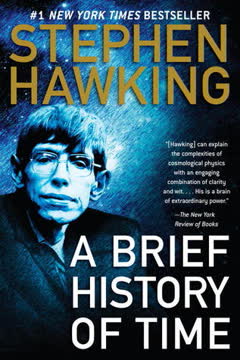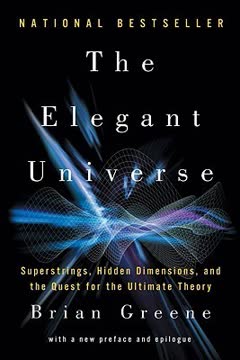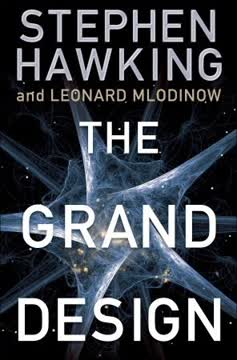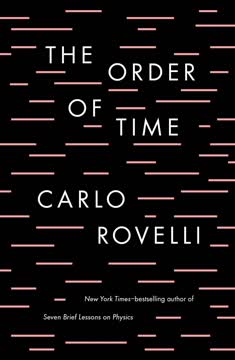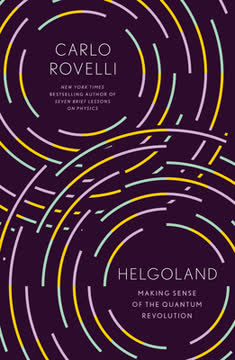نکات کلیدی
1. نظریه نسبیت عام اینشتین درک ما از فضا، زمان و گرانش را متحول کرد
اینشتین معادلهای نوشت که میگوید R معادل انرژی ماده است. به عبارت دیگر: فضا در جایی که ماده وجود دارد خم میشود. همین است. معادله در نیم خط جا میگیرد و چیز بیشتری نیست.
گرانش به عنوان خمیدگی فضا-زمان. بینش انقلابی اینشتین این بود که گرانش یک نیرو نیست، بلکه خمیدگی خود فضا-زمان است. این مفهوم زیبا پدیدههایی مانند موارد زیر را توضیح میدهد:
- مدارهای سیارهای: سیارات در مسیرهای بیضوی به دور خورشید حرکت میکنند زیرا از خمیدگی طبیعی فضا-زمان که توسط جرم خورشید ایجاد شده است، پیروی میکنند.
- خمیدگی نور: اجسام عظیم مانند ستارگان میتوانند پرتوهای نور را که از نزدیکی آنها عبور میکنند، خم کنند، اثری که در طول کسوفهای خورشیدی مشاهده میشود.
- اتساع زمان: زمان در میدانهای گرانشی قویتر کندتر میگذرد، پدیدهای که توسط ساعتهای اتمی دقیق در ارتفاعات مختلف تأیید شده است.
پیشبینیها و تأییدها. نسبیت عام چندین پیشبینی شگفتانگیز انجام داد که از آن زمان تأیید شدهاند:
- سیاهچالهها: مناطقی از فضا-زمان که در آن گرانش به قدری شدید است که هیچ چیز، حتی نور، نمیتواند از آن فرار کند
- امواج گرانشی: امواجی در فضا-زمان که توسط اجسام عظیم شتابدار ایجاد میشوند و برای اولین بار در سال ۲۰۱۵ شناسایی شدند
- جهان در حال انبساط: معادلات نظریه به طور طبیعی به مفهوم یک جهان در حال انبساط منجر شدند که بعداً توسط مشاهدات تأیید شد
2. مکانیک کوانتومی طبیعت عجیب و احتمالی دنیای زیراتمی را آشکار کرد
هایزنبرگ تصور کرد که الکترونها همیشه وجود ندارند. آنها فقط زمانی وجود دارند که کسی یا چیزی آنها را مشاهده کند، یا بهتر بگوییم، زمانی که با چیزی دیگر تعامل دارند.
دوگانگی موج-ذره. مکانیک کوانتومی نشان داد که موجودات زیراتمی مانند الکترونها و فوتونها میتوانند به عنوان ذرات و امواج رفتار کنند، بسته به اینکه چگونه مشاهده میشوند. این منجر به مفاهیم غیرمستقیم مانند موارد زیر شد:
- اصل عدم قطعیت: غیرممکن است که به طور همزمان هم موقعیت دقیق و هم تکانه یک ذره را بدانیم
- برهمنهی: ذرات میتوانند به طور همزمان در چندین حالت وجود داشته باشند تا زمانی که مشاهده شوند
- تونلزنی کوانتومی: ذرات میتوانند از موانعی عبور کنند که فیزیک کلاسیک میگوید نباید بتوانند
طبیعت احتمالی. برخلاف فیزیک کلاسیک، مکانیک کوانتومی با احتمالات سروکار دارد نه قطعیتها:
- تابع موج: تمام حالتهای ممکن یک سیستم کوانتومی را توصیف میکند
- فروپاشی تابع موج: با اندازهگیری، سیستم یکی از حالتهای ممکن را "انتخاب" میکند
- درهمتنیدگی: ذرات میتوانند "درهمتنیده" شوند، به طوری که حالت یکی بلافاصله بر دیگری تأثیر میگذارد، بدون توجه به فاصله
3. کیهان: از زمین مسطح تا جهانی در حال انبساط با میلیاردها کهکشان
جهان به عنوان یک توپ کوچک آغاز شد و سپس به ابعاد کیهانی کنونی خود منفجر شد. این تصویر کنونی ما از جهان است، در بزرگترین مقیاسی که میشناسیم.
کیهانشناسی در حال تکامل. درک ما از جهان به طور چشمگیری در طول زمان گسترش یافته است:
- زمین مسطح با آسمان در بالا
- زمین کروی در مرکز کیهان
- منظومه شمسی هلیوسنتریک
- کهکشان راه شیری به عنوان یکی از بسیاری از کهکشانها
- جهان در حال انبساط که از بیگ بنگ سرچشمه گرفته است
مدل کنونی. مدل کیهانشناسی مدرن شامل موارد زیر است:
- بیگ بنگ: جهان حدود ۱۳.۸ میلیارد سال پیش به عنوان یک حالت بسیار داغ و متراکم آغاز شد
- تورم کیهانی: دورهای از انبساط سریع در اوایل جهان
- ماده تاریک و انرژی تاریک: اجزای مرموزی که بیشتر جرم و انرژی جهان را تشکیل میدهند
- تابش زمینه کیهانی: تابش باقیمانده از اوایل جهان که شواهدی برای بیگ بنگ ارائه میدهد
4. ذرات بنیادی: سازندههای همه ماده و انرژی
همه چیزهایی که لمس میکنیم از الکترونها و این کوارکها ساخته شدهاند.
مدل استاندارد. نظریه کنونی فیزیک ذرات، ذرات و نیروهای بنیادی را توصیف میکند:
ذرات:
- کوارکها: شش نوع، که پروتونها و نوترونها را تشکیل میدهند
- لپتونها: شامل الکترونها و نوترینوها
- بوزونها: ذرات حامل نیرو مانند فوتونها و گلوئونها
نیروها:
- نیروی هستهای قوی: کوارکها را به هم متصل میکند
- نیروی هستهای ضعیف: مسئول واپاشی رادیواکتیو
- نیروی الکترومغناطیسی: تعاملات بین ذرات باردار
- گرانش: هنوز در مدل استاندارد گنجانده نشده است
نظریه میدان کوانتومی. ذرات به عنوان تحریکات میدانهای کوانتومی زیرین که در تمام فضا نفوذ میکنند، دیده میشوند. این چارچوب به توضیح پدیدههایی مانند موارد زیر کمک میکند:
- ذرات مجازی: ذرات گذرا که به وجود میآیند و از بین میروند
- جفتهای ذره-پادذره: ایجاد و نابودی خود به خودی ماده و پادماده
5. گرانش کوانتومی: تلاش مداوم برای متحد کردن نسبیت عام و مکانیک کوانتومی
گرانش کوانتومی حلقهای تلاشی برای ترکیب نسبیت عام و مکانیک کوانتومی است. این یک تلاش محتاطانه است زیرا فقط از فرضیاتی استفاده میکند که قبلاً در این نظریهها وجود دارند و به طور مناسب بازنویسی شدهاند تا با هم سازگار شوند.
مشکل ناسازگاری. نسبیت عام و مکانیک کوانتومی، در حالی که هر دو در حوزههای خود بسیار موفق هستند، اساساً ناسازگارند:
- نسبیت عام: گرانش را به عنوان خمیدگی صاف و پیوسته فضا-زمان توصیف میکند
- مکانیک کوانتومی: جهان را به صورت کوانتای گسسته و احتمالی توصیف میکند
رویکردها به گرانش کوانتومی:
- نظریه ریسمان: پیشنهاد میکند که ذرات بنیادی در واقع ریسمانهای کوچک مرتعش در ابعاد متعدد هستند
- گرانش کوانتومی حلقهای: پیشنهاد میکند که خود فضا به واحدهای گسستهای به نام "حلقهها" کوانتیده شده است
- نظریه مجموعه علّی: فضا-زمان را به عنوان مجموعهای گسسته از رویدادها با روابط علّی مدل میکند
چالشها و پیامدها. توسعه نظریهای از گرانش کوانتومی میتواند:
- ماهیت تکینگیهای سیاهچاله را توضیح دهد
- بینشهایی در مورد منشأ جهان ارائه دهد
- همه نیروهای بنیادی را در یک چارچوب واحد متحد کند
6. ماهیت زمان: توهم یا واقعیت؟
افرادی مانند ما که به فیزیک اعتقاد دارند، میدانند که تمایز بین گذشته، حال و آینده چیزی جز یک توهم پایدار و سرسخت نیست.
زمان در فیزیک در مقابل تجربه انسانی. در حالی که ما زمان را به عنوان جریانی از گذشته به آینده درک میکنیم، فیزیک تصویر متفاوتی ارائه میدهد:
- جهان بلوکی: در نسبیت، گذشته، حال و آینده به طور همزمان وجود دارند
- عدم وجود "اکنون" جهانی: مفهوم رویدادهای همزمان در نسبیت خاص از بین میرود
- برگشتپذیری: بسیاری از قوانین بنیادی فیزیک نسبت به زمان متقارن هستند
ظهور پیکان زمان. جریان ظاهری زمان ممکن است از موارد زیر ناشی شود:
- ترمودینامیک: افزایش آنتروپی به زمان جهت میدهد
- مکانیک کوانتومی: اندازهگیری و دکوهرنس برگشتناپذیری ظاهری ایجاد میکنند
- کیهانشناسی: انبساط جهان جهت زمانی کیهانی فراهم میکند
سؤالات باز:
- چه چیزی باعث تجربه ذهنی ما از زمان میشود؟
- آیا در سطح کوانتومی تفاوت بنیادی بین گذشته و آینده وجود دارد؟
- چگونه زمان در نظریههای گرانش کوانتومی ظهور میکند؟
7. آگاهی و اراده آزاد: آشتی تجربه انسانی با قوانین فیزیک
"من" و "نورونهای مغزم" وجود ندارند. آنها یک چیز هستند. یک فرد یک فرآیند است: پیچیده و به شدت یکپارچه.
مسئله سخت آگاهی. چگونه تجربه ذهنی از فرآیندهای فیزیکی در مغز به وجود میآید؟
- نظریه اطلاعات یکپارچه: پیشنهاد میکند که آگاهی یک خاصیت بنیادی از سیستمهای پردازش اطلاعات خاص است
- نظریه فضای کاری جهانی: پیشنهاد میکند که آگاهی از پخش اطلاعات در سراسر مغز به وجود میآید
اراده آزاد در یک جهان تعیینگرا. آشتی حس اراده آزاد ما با قوانین تعیینگرای فیزیک:
- سازگاریگرایی: اراده آزاد با تعیینگرایی سازگار است اگر اعمال ما از انگیزهها و خواستههای خودمان ناشی شوند
- اراده آزاد لیبرترینی: پیشنهاد میکند که عدم قطعیت کوانتومی اجازه میدهد تا در تصمیمگیریها به طور واقعی تصادفی باشد
پیامدها و تأملات:
- تصمیمات ما نتیجه فرآیندهای عصبی پیچیده هستند، نه یک "خود" جداگانه
- آگاهی و اراده آزاد ممکن است ویژگیهای ظهور یافته سیستمهای بسیار پیچیده باشند
- درک این پدیدهها میتواند پیامدهای عمیقی برای اخلاق، قانون و حس خود ما داشته باشد
آخرین بهروزرسانی::
FAQ
What's "Seven Brief Lessons on Physics" about?
- Overview of Modern Physics: "Seven Brief Lessons on Physics" by Carlo Rovelli provides a concise overview of the most significant developments in physics during the twentieth century.
- Seven Key Topics: The book is structured around seven lessons, each focusing on a fundamental aspect of modern physics, such as relativity, quantum mechanics, and the architecture of the cosmos.
- Accessible to All: It is written for readers with little to no background in science, aiming to make complex ideas comprehensible and engaging.
- Philosophical Insights: Beyond scientific concepts, the book also explores the philosophical implications of these discoveries on our understanding of reality and ourselves.
Why should I read "Seven Brief Lessons on Physics"?
- Simplifies Complex Concepts: Rovelli distills complex scientific theories into digestible lessons, making it an excellent introduction to modern physics.
- Broadens Understanding: The book offers insights into how the universe works, enhancing your appreciation of the natural world.
- Philosophical Reflection: It encourages readers to reflect on the philosophical questions raised by scientific discoveries, such as the nature of time and reality.
- Cultural Impact: As an international bestseller, it has been praised for its poetic and accessible approach to science, making it a cultural touchstone for understanding physics.
What are the key takeaways of "Seven Brief Lessons on Physics"?
- Relativity and Space-Time: Einstein's theory of general relativity revolutionized our understanding of gravity, showing that space and time are interconnected and dynamic.
- Quantum Mechanics: The book explains the probabilistic nature of quantum mechanics, where particles exist in states of probability rather than certainty.
- Cosmic Architecture: It describes the vast and complex structure of the universe, from galaxies to the potential existence of multiple universes.
- Human Perspective: Rovelli emphasizes that our understanding of physics also reshapes our understanding of ourselves and our place in the universe.
What are the best quotes from "Seven Brief Lessons on Physics" and what do they mean?
- "The most beautiful of theories": This refers to Einstein's general theory of relativity, highlighting its elegance and profound impact on our understanding of gravity and the cosmos.
- "Reality is not as it appears": This quote underscores the book's theme that scientific discoveries often reveal a world far different from our everyday perceptions.
- "We are made of the same stardust": This poetic expression emphasizes the interconnectedness of all matter in the universe, including humans, reinforcing the idea that we are part of a larger cosmic story.
- "The flow of time is an illusion": This challenges our intuitive understanding of time, suggesting that time may not be a fundamental aspect of reality as traditionally thought.
How does Carlo Rovelli explain Einstein's theory of relativity in "Seven Brief Lessons on Physics"?
- Space and Gravity: Rovelli explains that Einstein's theory shows gravity is not a force but a curvature of space-time caused by mass.
- Time Dilation: The theory predicts that time passes at different rates depending on the gravitational field, leading to phenomena like time dilation.
- Simple Equations: Rovelli highlights the simplicity and elegance of Einstein's equations, which describe how matter and energy influence the curvature of space-time.
- Impact on Physics: The theory of relativity has profound implications for our understanding of the universe, influencing everything from the motion of planets to the behavior of light.
What is quantum mechanics according to "Seven Brief Lessons on Physics"?
- Probabilistic Nature: Quantum mechanics describes the behavior of particles at the smallest scales, where outcomes are probabilistic rather than deterministic.
- Wave-Particle Duality: Particles like electrons exhibit both wave-like and particle-like properties, depending on how they are observed.
- Quantum Entanglement: Rovelli discusses phenomena like entanglement, where particles become interconnected in ways that defy classical understanding.
- Philosophical Implications: The theory challenges traditional notions of reality, suggesting that observation plays a crucial role in determining the state of a system.
How does "Seven Brief Lessons on Physics" describe the architecture of the cosmos?
- Expanding Universe: The book explains that the universe is expanding, a discovery that has reshaped our understanding of cosmic history.
- Galaxies and Stars: Rovelli describes the vast number of galaxies, each containing billions of stars, highlighting the scale and complexity of the cosmos.
- Curved Space: The universe is not flat but curved, with space-time being influenced by the mass and energy it contains.
- Big Bang and Beyond: The book touches on the origins of the universe with the Big Bang and speculates on the possibility of other universes.
What does Carlo Rovelli say about particles in "Seven Brief Lessons on Physics"?
- Elementary Particles: Rovelli explains that everything is made of a few types of elementary particles, such as quarks and electrons.
- Quantum Fields: These particles are excitations of underlying quantum fields, which are dynamic and constantly fluctuating.
- Standard Model: The book discusses the Standard Model of particle physics, which describes the fundamental forces and particles but also highlights its limitations.
- Dark Matter: Rovelli mentions the mystery of dark matter, which is not accounted for by the Standard Model but is essential for understanding the universe's structure.
What is loop quantum gravity as explained in "Seven Brief Lessons on Physics"?
- Combining Theories: Loop quantum gravity is an attempt to reconcile general relativity and quantum mechanics into a single coherent framework.
- Grains of Space: The theory suggests that space is not continuous but made up of discrete 'atoms' or 'grains' of space.
- No Absolute Time: It proposes that time is not a fundamental aspect of reality but emerges from the interactions of these space quanta.
- Experimental Challenges: While promising, the theory is still largely theoretical, with ongoing efforts to find experimental evidence.
How does "Seven Brief Lessons on Physics" address the concept of time?
- Time and Heat: Rovelli links the flow of time to thermodynamics, suggesting that time's arrow is related to the increase of entropy.
- Illusion of Flow: The book argues that the flow of time is an emergent phenomenon, not a fundamental aspect of reality.
- Relativity of Time: Time is not universal but relative, varying with speed and gravity, as shown by Einstein's theories.
- Philosophical Questions: Rovelli explores the philosophical implications of these ideas, questioning our intuitive understanding of past, present, and future.
What philosophical insights does Carlo Rovelli offer in "Seven Brief Lessons on Physics"?
- Interconnectedness: Rovelli emphasizes the interconnectedness of all things, suggesting that our understanding of the universe also informs our understanding of ourselves.
- Nature of Reality: The book challenges traditional notions of reality, proposing that what we perceive is only a small part of a much larger and more complex whole.
- Human Perspective: Rovelli reflects on the human place in the universe, suggesting that our knowledge and consciousness are part of the natural world.
- Curiosity and Knowledge: He celebrates human curiosity and the pursuit of knowledge as fundamental aspects of our nature, driving us to explore and understand the cosmos.
How does "Seven Brief Lessons on Physics" conclude on the topic of human existence?
- Part of the Universe: Rovelli concludes that humans are an integral part of the universe, made of the same elements and subject to the same laws as everything else.
- Ephemeral Nature: He reflects on the ephemeral nature of human life, suggesting that our awareness of mortality gives life its value.
- Curiosity and Exploration: The book celebrates human curiosity and the drive to explore, which have led to our understanding of the universe.
- Home in Nature: Rovelli emphasizes that nature is our home, and understanding it helps us understand ourselves and our place in the cosmos.
نقد و بررسی
کتاب هفت درس کوتاه درباره فیزیک یک مرور مختصر و شاعرانه از مفاهیم پیچیده فیزیک برای عموم ارائه میدهد. خوانندگان از نوشتار زیبا و توانایی روولی در توضیح ایدههای دشوار قدردانی میکنند، هرچند برخی آن را بیش از حد سادهشده میدانند. این کتاب موضوعاتی مانند نسبیت، مکانیک کوانتومی و کیهانشناسی را در فصلهای کوتاه پوشش میدهد. بسیاری از دسترسیپذیری و سبک شاعرانه آن تمجید میکنند، در حالی که دیگران خواهان عمق بیشتری هستند. بهطور کلی، این کتاب به عنوان یک مقدمه زیبا و اندیشهبرانگیز به فیزیک مدرن دیده میشود که کنجکاوی را برمیانگیزد، حتی اگر توضیحات جامع ارائه ندهد.
Similar Books


